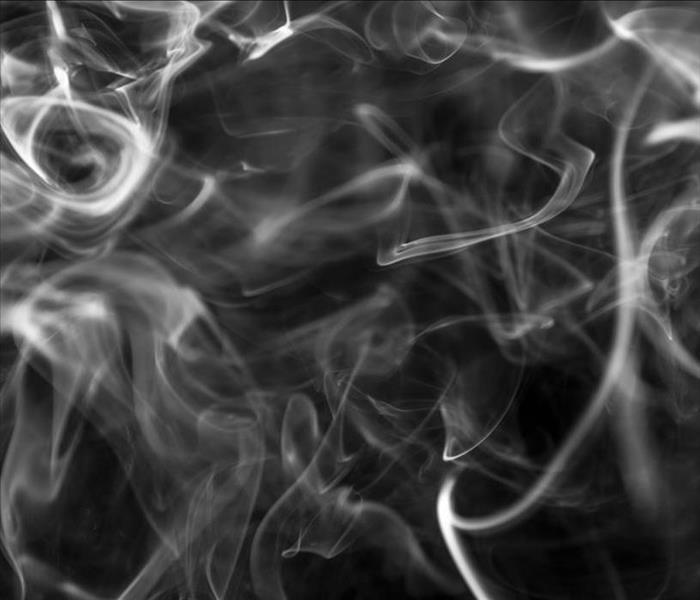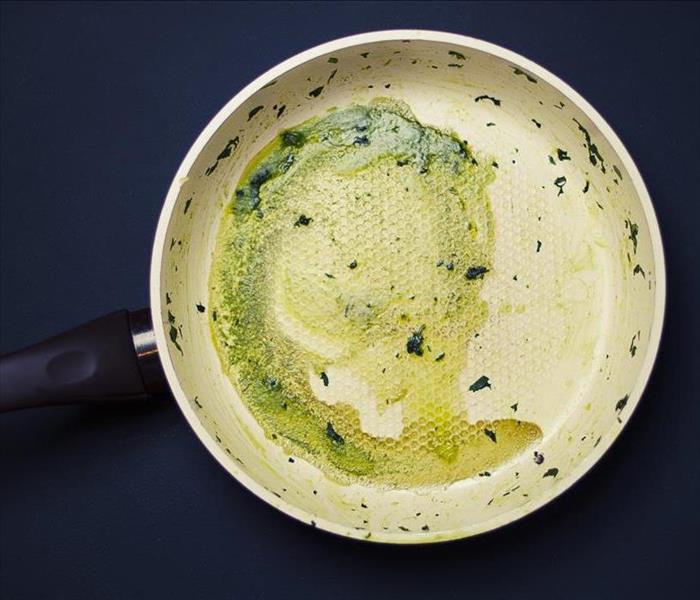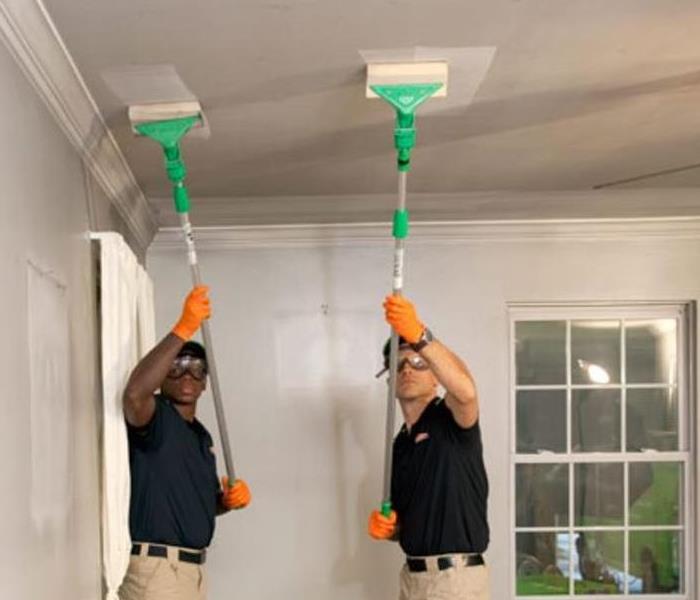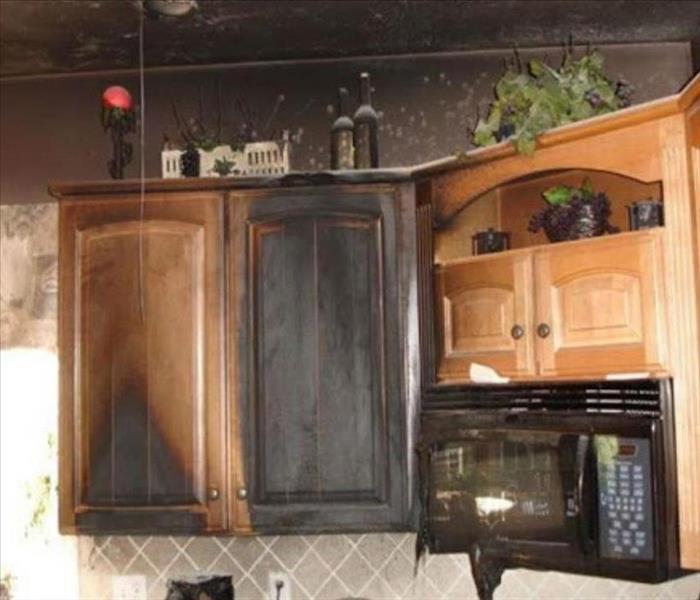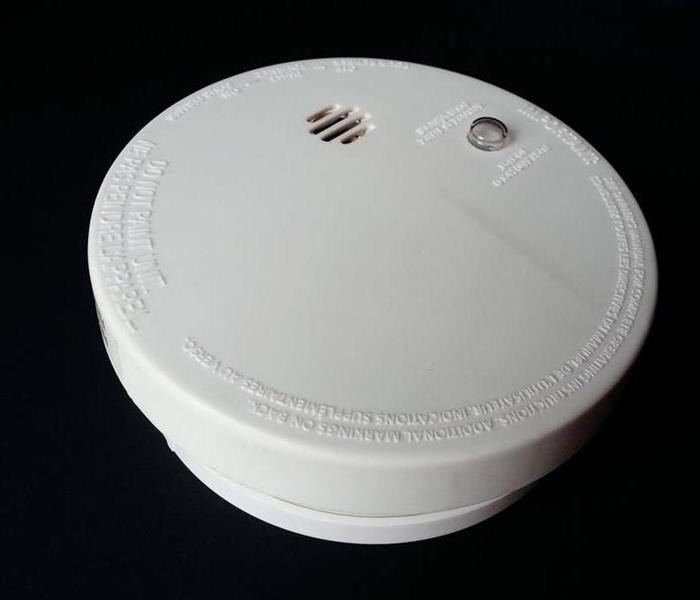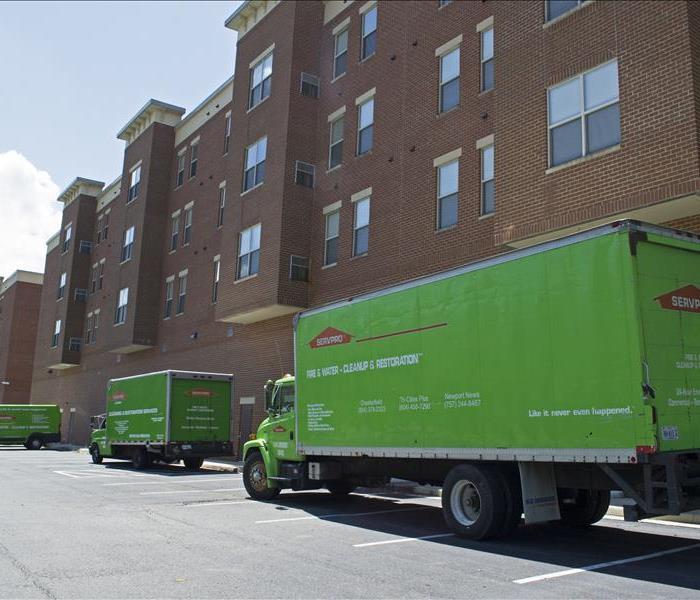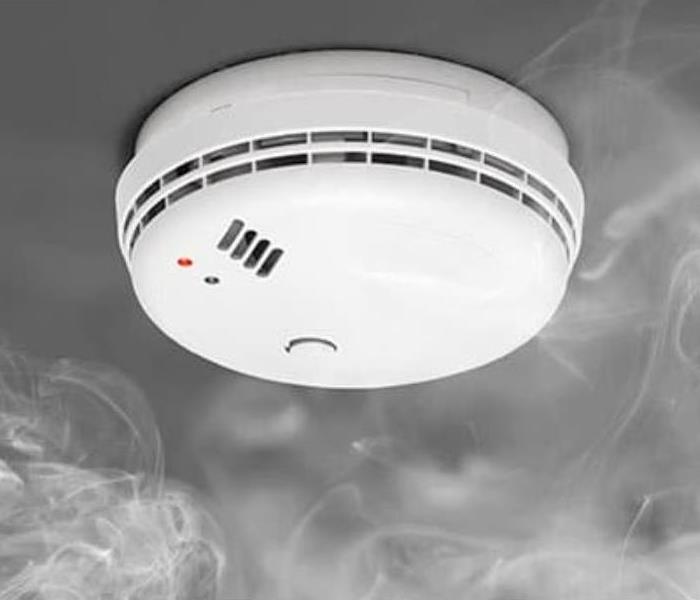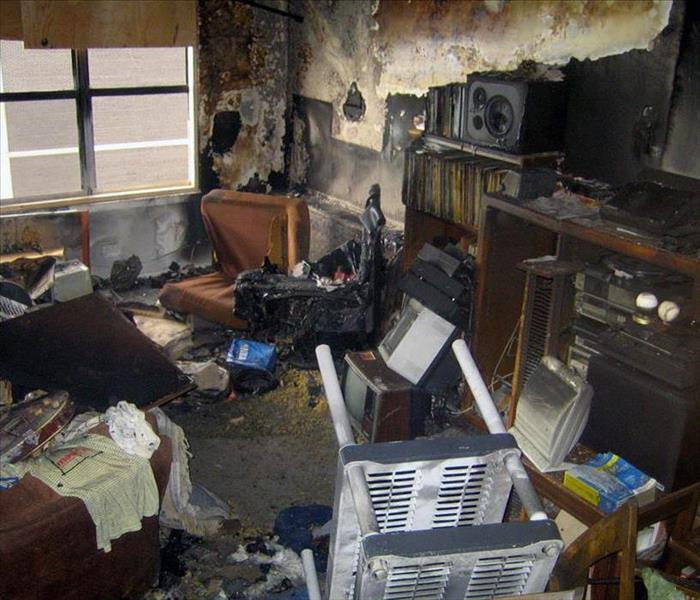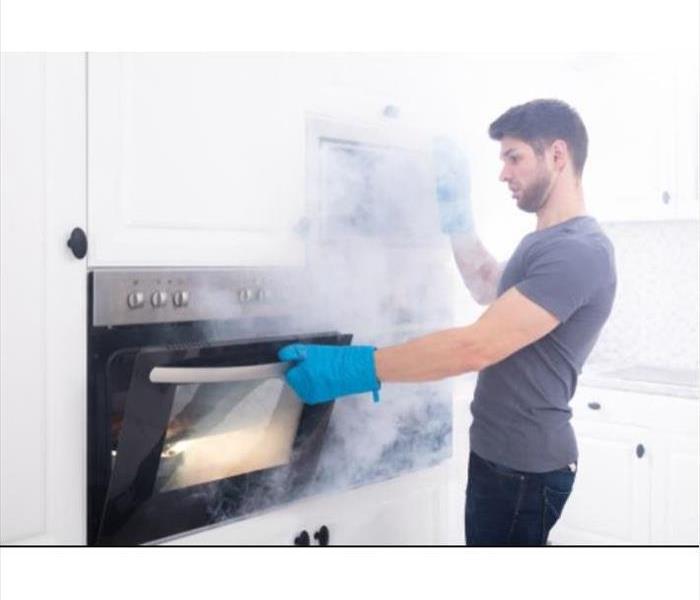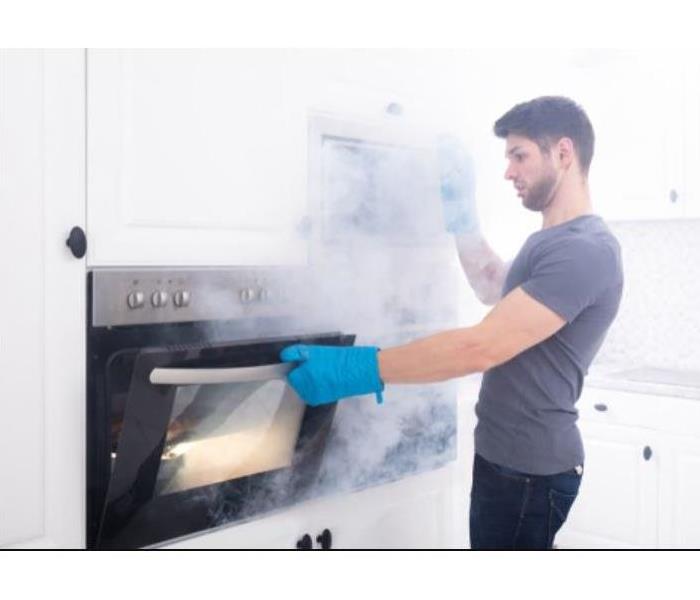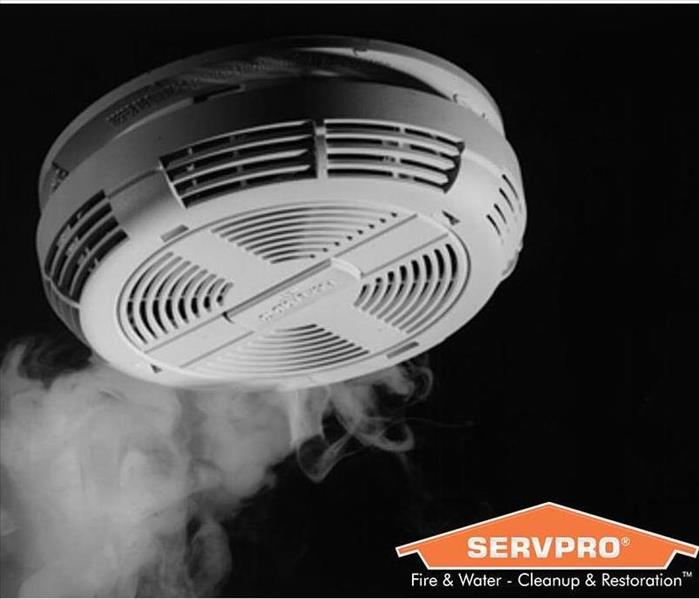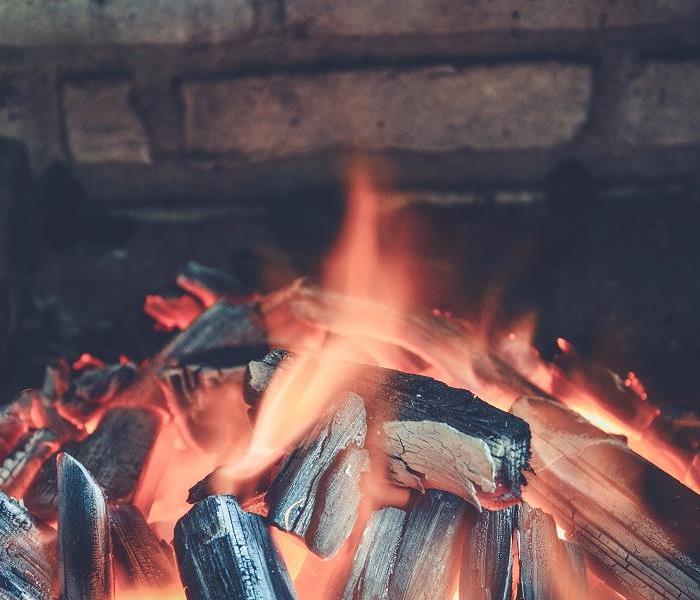Recent Fire Damage Posts
Types of Smoke Residue
1/17/2022 (Permalink)
When your home or business experiences a fire, there’s more to the damage than just what’s been directly burnt by the fire. Smoke and soot can cover your home in difficult to clean residue and leave an odor that no one wants lingering.
There are four common kinds of smoke damage: dry smoke, protein residue, fuel/oil residue, and wet smoke. Each of these are caused by the different circumstances of the fire such as the temperature, location and the materials that are fueling the fire. They all also vary in means of restoration process as well.
Dry Smoke – Fires that are fast burning and high temperature are what creates dry smoke. These fires are typically fueled by paper or wood. It has a powdery texture that makes it slightly easier to clean than some other kinds of smoke residue, however this same texture also makes it easy to fall into porous materials. This can make the odor harder the fix as even when the house appears clean the particles responsible for the smell are trapped inside the porous materials of your home. Fortunately, the odors of dry smoke are not as strong as some of the other smoke odors and a professional remediation company can easily handle these unwanted smells.
Protein Residue – This kind of smoke damage is caused when organic materials evaporate during a fire with low heat. Most commonly when there is an accident in the kitchen and a cooking fire happens. This residue, while there’s not any noticeable soot or streaking, can still permanently discolor finished surfaces with a yellowish-brown residue. Unfortunately, the smell that is left behind is also pretty unpleasant and can easily fill your home if left.
Fuel/Oil Residue – While fuel/oil fires are not all that common in homes, furnaces can have what’s called a puffback where the soot and smoke from inside the furnace are blown back into the house instead of out the chimney. This residue is very sticky and dense making it difficult to clean up as well has carrying a particularly unpleasant smell that can run belongings and furniture if not treated promptly and properly.
Wet Smoke – This is typically caused by the thick black smoke that comes off of low-heat, smoldering fires fueled by rubber or plastics. The smoke is very sticky and dense, easily covering your house in a heavy coating of offensive smelling residue. This smoke residue is also prone to smearing making it difficult to clean up without special equipment and proper techniques.
SERVPRO of Chesapeake North knows that trying to get back to normal after a fire in your home can be difficult. That’s why our team constantly trains to help ensure that we are using the latest techniques in fire damage remediation and make your home’s fire damage “Like it never even happened.”
What To Know About Grease Fires
1/7/2022 (Permalink)
Cooking is the number one cause of fires and fire injuries in the household. Thousands of cooking fires devastate homes and families every year, and grease/oil are often the cause. Keep reading for some tips on how to prevent a grease fire in your home.
- Never leave the kitchen while frying your food. This applies to all forms of cooking but is especially true when there is a large amount of oil involved.
- If there is a strong smell, or smoke coming off of the oil in your pot/pan that’s a good sign that the oil is burning, and you should take it off the heat to let it cool and lower the burner temperature, so it doesn’t happen again
- Keep a lid that can cover your pot/pan. In the event that a fire starts, a lid that seals the fire in can be a quick way to safely eliminate a fire in your kitchen without having to use an extinguisher.
- Make sure that nothing flammable is around the stovetop
While accidents can and do happen, following proper safety procedures and cooking techniques can make grease fires significantly less likely to happen to you and your family.
SERVPRO After Fire Cleaning and Restoration
12/2/2021 (Permalink)
When your house is struck by fire damage the structure of the home is not the only thing seriously affected. All of your belongings, furniture, clothes, and other items are likely also damaged by soot and smoke. This is why at SERVPRO with our “restore” not “replace” mentality we specialize in restoring your belongings to save you money, as well as to help ensure those irreplaceable items are protected and taken care of.
Our team is trained in several methods for cleaning and restoring your belongings depending on what material and damage has been done, including:
- Wet Cleaning – Effective for Moderate to heavy residues
- Dry Cleaning - Used for lighter residues or to prepare/pre-treat for wet cleaning
- Immersion Cleaning – Items are submersed in a bath of the cleaning products
- Foam Cleaning – For upholstery fabrics that might be otherwise damaged by wet cleaning techniques
- Abrasive Cleaning – The surfaces of the items are agitated while cleaning
In the event that your home needs extensive restoration SERVPRO also offers a Move-Out service. This allows for a faster restoration process, protecting your items from damage on site. Once the job is complete we will work with you to coordinate a move-in based on your needs.
Fire Recovery Steps
11/11/2021 (Permalink)
Unfortunately, accidents happen. Fires can cause untold damage to your home, some of which you may not even know about. It is important to know how to respond once the fire is taken care of so that your house can get taken care of too and you can get back to living your life as fast as possible. These are the steps that we will take to clean up after fire damage so that you have a better understanding of what to expect!
First our team will come to your house for an assessment of the damage and how we can best help you. It’s important to know that while you will probably want to get cleaning immediately, you should wait until the crew completes their initial assessment as they will know the best way to proceed.
Next begins the mitigation. Smoke, soot, and fire damage are not the only things that you have to worry about after a fire. Professionals will make sure that any holes, broken windows, or doors are boarded up to protect your home from the elements. This also may include covering the roof as well.
After mitigation the crew will begin removal. One major part of fire damage recovery is water removal. Firefighters use a huge amount of water to make sure that all of the fire in your home is put out, and the first step of the removal process is often to remove all the standing water and begin drying out your things.
Once things are dry and any damaged parts of the home are removed the next step is sanitation. Clothing and electronics, as well as furniture and any other belongings may have been contaminated by soot and need to be cleaned by professionals.
Finally, once everything is removed and cleaned repairs can begin. This is where things will finally start to get back to normal. Professionals will repair windows and walls, flooring, siding, and even repainting walls and installing new carpet if required.
Fires in your home can certainly be traumatic but you can rest assured knowing that our highly trained professionals here at SERVPRO of Chesapeake North are here to help.
Smoke Detectors Save Lives - Here's What You Should Know
10/28/2021 (Permalink)
Everyone knows that fire detectors are an essential part of making sure your home stays safe and your family is protected, but how much do you really know about their proper use and installation?
Smoke detectors last between eight and ten years, typically you can find the manufacturing date printed somewhere and sometimes the expiration is also printed, but at a minimum they should be replaced every 10 years – An old smoke detector is just as bad as not having one at all
It may also need to be replaced if the detector alarms or chirps for no reason, or if there is no manufacturer date or expiration date.
- Smoke Detectors should be installed on every level of the home as well as in every sleeping area too.
- They should NOT be installed in cooking areas or inside of/near bathrooms
- Make sure to keep them clean of dust and cobwebs
- Check them once a month to ensure proper function, and batteries should be changed AT LEAST once a year. It can be a good idea to use changing the clocks forward or backwards as a reminder to also change your smoke detector batteries
We truly hope you’ll never have to hear these alarms for real, but with these tips you can help ensure that your family and home is safe should you ever have to deal with a house fire and should you need our emergency fire and water services, SERVPRO of Chesapeake North is here to help 24/7, 365 days a year.
Fire Prevention Week - Apartment Safety
10/4/2021 (Permalink)
This week is National Fire Prevention Week. Our SERVPRO of Chesapeake North team wants you and your family or household to be fully prepared in case of an emergency. A lot of times when we talk about smoke alarms and escape plans, we are referring to what to do when you’re in a home. But a vast population dwell in apartment buildings and escape plans can look a lot different. Check out these tips and facts from the National Fire Protection Association:
- Always know all the exit locations from your apartment floor
- If you hear the fire alarm, touch the exit food before opening. If it’s hot, use another way out, if it’s cool, exit through that door
- Always close doors behind you as you leave and make sure you grab your keys
- If fire or smoke is blocking all your exits, keep the door shut in your apartment and cover cracks around the door with towels. Call 9-1-1 and signal to the fire department that you’re inside your apartment with a flashlight flickering or waving a cloth.
- Everyone in the building should know where to find the manual fire alarm boxes (alarm boxes on the wall with a pull bar). Most are found within five feet of an exit door
- If there is a fire, pull the manual fire alarm box handle on your way out of the building.
- Stay outside at your meeting place until you are told the building is safe.
- Meet with your landlord or building manager to learn about the fire safety features and plans in your building.
How Smoke Hurts Your Home
1/18/2021 (Permalink)
House fires are reported to fire departments about every 24 seconds and cost thousands of lives each year and thousands to homes and buildings.
Smoke and fire damage can be severe and if the home survives the fire, it should be inspected, quickly, cleaned and recovery actions addressed to avoid permanent damage.
When you've been told it's safe to return to your home, call your insurance company and ask for a cleanup and restoration company to help you with the fire and smoke damage to help restore your home.
Thankfully, your home is still standing, but you must get an inspection of the foundation and the structure for safety.
If the fire consumed your furniture and belongings, you have a wet, scorched mess left behind. Leather, fabric, and wood can trap smoke smells and usually can be restored. In addition, smoke and soot particles can get trapped inside of your HVAC system.
SERVPRO® of Chesapeake North will remove the wet, burned, scorched mess and take your salvageable contents to clean in our warehouse. We also have the capability to help restore your fire and water damaged documents and photos. When this process is completed, then we can address the soot, water, and fire damage restoration to your home and to your HVAC system.
If you have fire damage in Chesapeake, call us at 757-465-9700.
Is Your Home Prepared In Case of Fire?
1/11/2021 (Permalink)
More often then not, the sound from a smoke detector is more reliable than your senses to alert you of a fire when you are sound asleep.
Many people think that they will wake up because they will be able to smell the smoke. This more often times not true, because your sense of smell shuts down when you sleep, and your sense of hearing is more active.
The National Fire Protection Association reported that 2 out 5 home fires that sustained fire damage, either did not have smoke alarms or they were disabled.
Make sure that your alarm is placed properly and in every room of the home. It is also important to make sure the alarms are installed correctly to ensure it's effectiveness and efficiency. Test your alarms every year or so to make sure they are in working order.
SERVPRO of Chesapeake North can answer your questions about Fire, Smoke, or Soot Damage at 757-465-9700.
What To Do After A Fire
10/20/2020 (Permalink)
While the fire is always the immediate danger, once it's gone, what it leaves behind will continue to affect your home and everything inside it. Ash and smoke, if left and not cleaned by professionals, will leave extensive corrosion, etching and discoloration and don't forget about those lingering odors. So what's the first step to your homes recovery and what should you know?
- Don't risk doing further damage by attempting to clean up the damage yourself.
- You should call your insurance carrier and file a claim.
- Then call SERVPRO of Chesapeake North to assess the damage. We will then communicate with your insurance company to plan the damage recovery process, and the process will be explained to you.
The sooner you contact us the better, because damage will continue and your structure and all your contents will have much more extensive damage to them. Carpets may become permanently discolored, glass may be severely etched and those odors aren't just odors. They're acidic and filled with toxins that can be harmful to you and the longer they stay, the more damage it will cause on your home.
Keys Things to Avoid:
- Do not wipe or attempt to wash residue from walls, ceilings, or absorbent surfaces.
- Do not use carpeting or upholstered furniture impacted by heavy smoke residue or debris.
- Do not use food items or canned goods exposed to heat.
- Don't turn on computers, TV's, stereos or electrical appliances until they have been professionally cleaned and checked.
Fire Prevention Week 2020
10/7/2020 (Permalink)
Every year, the National Fire Protection Agency dedicates a week in October to Fire Safety and Prevention. This year's theme is: Serve Up Fire Safety In The Kitchen.
Here are some tips to keep in mind while cooking in the kitchen:
- the #1 cause of home fires in the kitchen is unattended cooking
- stay in the kitchen while grilling, frying, boiling, or broiling food
- check on food regular while simmering or baking items
- keep items away from stove that can easily catch fire
- keep a lid close by while cooking to place over a grease fire
- make a kid-free zone that is at least 3 feet away from the stove
- make sure a smoke alarm is installed in each room of the home
If you experience a fire in your home or business, contact the professionals at SERVPRO of Chesapeake North to clean and restore your home to pre-fire condition.
How to Get Rid of Smoke Odor
10/5/2020 (Permalink)
Now listen… we know things happen! But did you get caught up in some really intense scene on your favorite TV show and forgot about that pot of yummy food on the stove? Or maybe your toaster oven cooked that pizza a little faster than you expected? Sure enough, now your house smells like burnt food and that smell just won't go away! Before you grab that air freshener, hear us out!!
- Confirm the situation is under control: Before worrying about the odor, make sure there isn't an actual fire. Burnt food often smokes without catching on fire, but you don't want the situation to get out of hand if there are flames. Remove the pan from the burner and let it cool. Make sure the food is no longer burning or producing more smoke.
- Air out the house: Burnt food smoke inhalation isn't good for your lungs, so start by clearing out the smoke. Open windows in rooms close by, give the smoke and odor a place to go. Run ceiling fans and use box fans in the windows to help pull the smoke and odor out of the room faster. You can also run the vent on your fan hood and the exhaust fans in any nearby bathrooms.
- Remove the source of the smell: You’ve got to remove the burnt food to remove the burnt smell in the home. Once its cools COMPLETELY, dump the food into a trash bag, seal it, and remove from the home. If the pan is salvageable, soak it in hot, soapy water to release the burnt-on food, then scrub any remaining food off. Boiling water and vinegar in the pan can help soften the burnt spots. Scrubbing the pan with baking soda can also help clean it due to the gentle abrasive quality of the powder.
- Neutralize the burnt pan smell in the home: Don’t grab that air freshener yet! Air fresheners and candles just add scent to the mix without actually removing the bad smell. The combination of the burnt, smoky odor and the fragrance can sometimes smell worse than the burnt odor alone. Try something a little more natural to help remove the odor from the air! Bring water and white vinegar to a boil on the stove, and reduce the heat so it simmers. You can also add whole spices or fresh lemon slices to the boiling water for a natural scent. Coffee grounds and baking soda placed out in a container can help soak up bad odors.
- Wipe Down Surfaces: Smoke particles tend to stick to all areas of the home, which makes the smell linger. Be sure to clean all of the surfaces in your kitchen to help remove the odor. Wipe the stove, countertop, cabinets and walls with a warm, soapy water mixture or all-purpose cleaner. Choose cleaning products that are safe for specific surfaces, such as wood cabinetry or stone countertops.
Wash Fabric Items: As we said before, odors and smoke particles like to stick to all areas of the home, especially fabric items. Wash all items that came in contact with the smoke such as curtains, tablecloths, and flooring. If your carpets or rugs take on the burnt odor, sprinkle baking soda over them. Give the baking soda a few hours to soak up the smell. Vacuum the carpet well to remove all of the baking soda.
Why Smoke Alarms Are So Important
9/28/2020 (Permalink)
Why Are Smoke Alarms Important?
Smoke alarms not only alert you when there may be a fire in the home, but they can also save your life. You grow up learning the dangers of a fire in the home and are trained early on, on what to do. During a fire, smoke and flames will spread faster than you think. When the alarm sounds, you and your family know to rush out of the house as soon as possible.
Here are some tips to follow from the National Fire Protection Agency
- Replace your smoke alarm at least every 10 years
- Install a smoke alarm in every bedroom, on every level of the home, and in the basement
- It is recommended to use interconnected smoke alarms so when one sounds, they all sound
- At least once a month, test your smoke alarm by pressing the test button to ensure it's working
- Install your smoke alarms away from the kitchen to reduce false alarms and they should be placed on the ceiling or high up on walls
If you experience a fire or smoke damage in your home, please call the professionals at SERVPRO of Chesapeake North at 757-465-9700.
Holiday Fire Safety
12/10/2019 (Permalink)
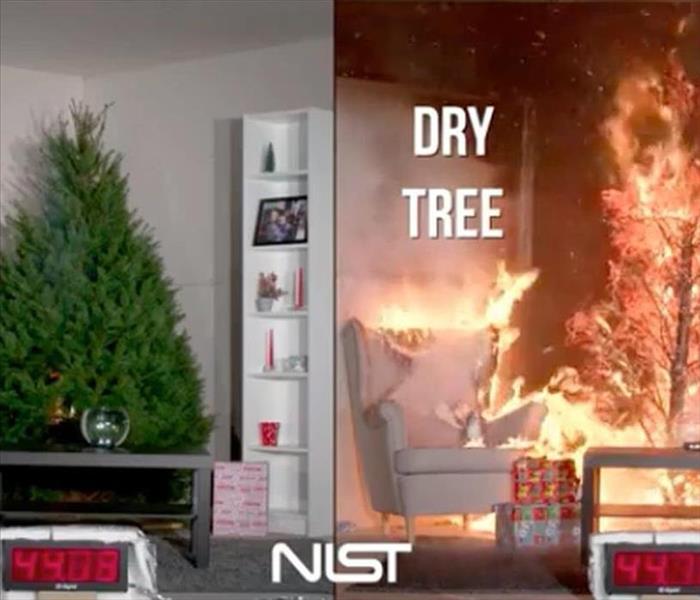 SERVPRO of Chesapeake North is always Here to help. Check out these tips on preventing fires this holiday season.
SERVPRO of Chesapeake North is always Here to help. Check out these tips on preventing fires this holiday season.
Did you know that Christmas trees are the culprit for hundreds of house fires every year? If you use a live tree in your home for the holidays, it is important to keep it well watered and hydrated. A dry tree can catch flames in just SECONDS if it comes into contact with an open flame or other ignition source such as a candle or an electrical short.
Be sure to review the manufacturer's safety information included with any electrical decorations to avoid an overload that can cause an electrical short.
Keep burning candled at least 12 inches from anything that is flammable such a curtains, trees paper, or wooden objects.
Make sure your Christmas tree is at least 3 feet away from any heat source including fireplaces, candles, radiators or heat vents. 1 in every 4 winter fires is caused from a tree being too close to a heat source!
SERVPRO Chesapeake North wants you, your family, and your property to stay safe. If you do experience a fire or water damage during the holidays, or any time of the year, our franchise professionals can make it “Like it never even happened.” Available 24 hours a day, 365 days a year, we are Here to Help.
Staying Warm & Safe This Winter!
12/5/2019 (Permalink)
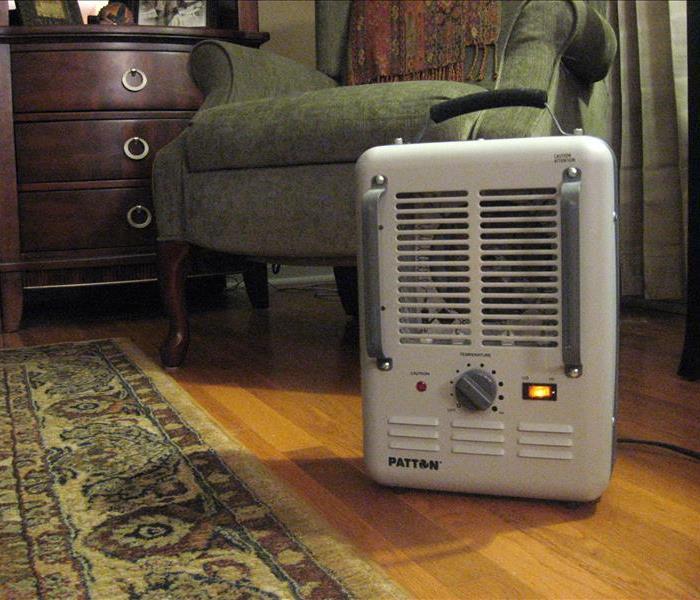 Did you know that space heaters account for 86% of fire related heating deaths?
Did you know that space heaters account for 86% of fire related heating deaths?
With winter weather approaching, it is important that we keep ourselves and our families warm during the winter months. We here at SERVPRO Chesapeake North want you, and your home or business to be prepared to safely heat your home or business.
Never heat your home or business with a gas top stove or oven. In addition to the risk of carbon monoxide poisoning, leaving an unattended stove can cause a fire.
Observe and implement all manufacturer warnings and instructions when using space heaters. Most home heating fire deaths (86%) involved stationary or portable space heaters.
Make sure that all heating equipment especially chimneys are cleaned regularly and inspected prior to use.
Keep heating equipment away from flammable materials such as furniture, clothing, bedding paper materials and other holiday decorations such as Christmas trees.
Almost half of all heating equipment related home fires occur in December, January, and February - So now is the time to clean, inspect and test all heating equipment to ensure that it is functioning properly.
SERVPRO Chesapeake North wants you, and your business to stay safe. If you do experience a fire or water damage during the holidays, or any time of the year, our franchise professionals can make it “Like it never even happened.” Available 24 hours a day, 365 days a year, we are Here to Help.
A Fire Escape Plan For Your Home
10/8/2019 (Permalink)
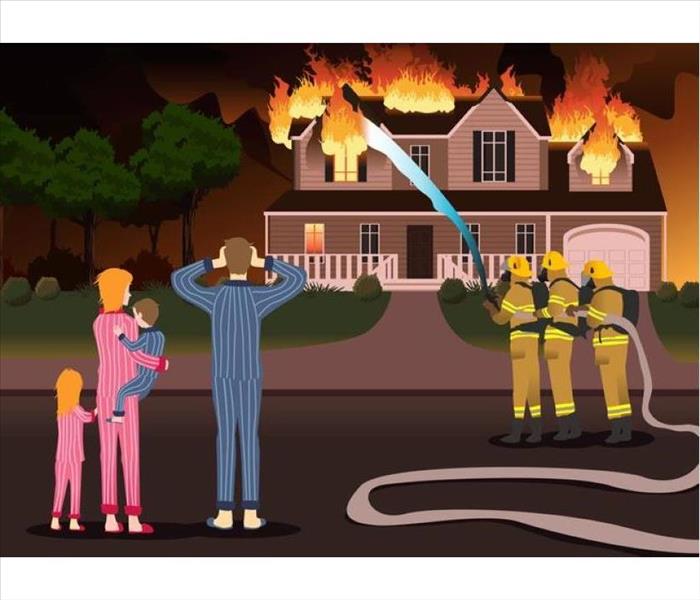 Fire & Smoke Damage Cleaning and Restoration in Chesapeake, 757-465-9700.
Fire & Smoke Damage Cleaning and Restoration in Chesapeake, 757-465-9700.
When a fire ignites, you may only have a few minutes to safely get everyone out of the house. It's imperative that you have a rehearsed escape plan before the event of a house fire. Here are some escape plan suggestions to help keep you and your loved ones safe from harm as quickly as possible.
Install Fire Alarms
Place fire alarms on every floor of your home and inside and outside of every bedroom. This will help to ensure that the alarm will be heard by most.
Map It
Map out your home's floor plan showing at least two ways to get out of a room. This is a great visual for children and a second exit option in case one is not accessible.
Discuss & Act on It
Discuss this escape floor plan with your family making special note to point out the exits to the children especially those in their bedroom. Afterwards, have a fire drill so that everyone is familiar as this will help in getting everyone out quickly and safely.
Choose a Meeting Place
It's important that everyone knows where to meet after getting out of the house safely. Places safely away from the fire like a mailbox across the street, a street sign, or a neighbor’s house.
Don't Wait
When you hear the smoke alarm, yell, scream, knock on doors as you are immediately exiting the house. No items or belongings are more valuable than yours and your loved one’s lives.
Call us with any questions about fire or smoke damage or about making a fire escape plan. We are "Always here to help." 757-465-9700.
Sources: National Fire Protection Association
How to Prevent a Dryer Fire
10/8/2019 (Permalink)
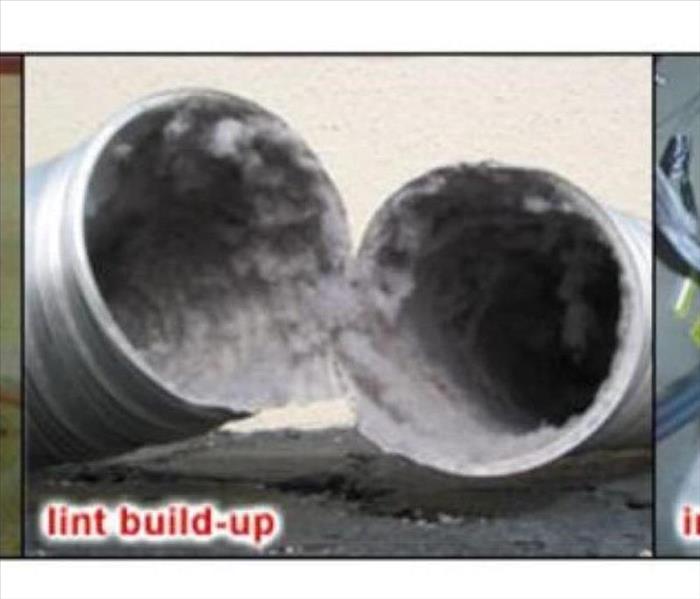 Dryer Vent Cleaning in Chesapeake, VA
Dryer Vent Cleaning in Chesapeake, VA
The U.S. Fire Administration reports that 2,900 home clothes dryer fires are reported each year and cause an estimated 5 deaths, 100 injuries, and $35 million in property loss. Thirty four percent of these fires are cause by people failing to clean their dryers and most dryer fires happen in the fall and winter months with a peak in January. Learn how you can help reduce the risks of your dryer setting fire.
Clean the Lint Screen
A good habit to form is to remove all the lint before beginning every load of laundry.
Inspect the Dryer Vent Hose
Look for a bent, or crushed hose and if you have a white plastic vent hose, you should quickly replace it with an aluminum vent hose. White vent hoses are no longer allowed to be sold as they are considered a safety hazard.
Clean the Dryer Vent System & Dryer
Clean the dryer vent system annually. Depending on where your system exits will determine if you need a professional to clean from the dryer to the exit point. It's important to be sure that there are no lint blockages in your vent system. Regularly use a vacuum to remove any excess lint from the inside of your dryer.
Remove Flammable Materials
Look for paper, clothing or cardboard that may have fallen behind or beside your dryer. Be sure to keep any flammable materials away from the dryer.
Contact us if you have any questions about dryer vent system cleaning at SERVPRO of Chesapeake North at 757-465-9700.
Sources: U.S. Fire Administration
Cleaning and Restoring Fire Damaged Contents in Chesapeake
6/10/2019 (Permalink)
 Fire Damage Cleanup in Chesapeake
Fire Damage Cleanup in Chesapeake
What to Consider when Cleaning Fire Damaged Contents
Depending on the extent of the fire, the damage to the contents in your home or office can be immense due to the salvage efforts by the fire department, or minimal due to only grease, smoke, or soot damage. Our SERVPRO® fire restoration team must evaluate and determine the best means to clean and restore your fire damaged items. Restoration methods can occur with dry-cleaning, cleaning with ultrasonic waves or with other specialized treatments to remove odors or preserve photos and documents. We take certain steps in determining how to best clean your contents.
Our first step would be to determine whether the item (s) can be restored or are they non-salvageable. Contents with smoke or soot damage usually can be restored, such as photos or documents, however, burned or charred items would be considered a loss.
The durability of the fabric, or the material of the damaged item (s) is considered when determining the cleaning and restoration method. Delicate items subjected to the fire incident may not withstand even our most gentle of treatments.
The porosity of an item is important in determining the best cleaning and restoration method. Porous items such as clothing and textiles can benefit from our ozone treatment to dry cleaning. Delicate, non-porous items made of glass or ceramic, can more than likely be immersed and cleaned with ultrasonic waves. More delicate porous items are handled more carefully and limited to moisture exposure.
We recommend always having your fire damaged items cleaned by a professional restoration company. SERVPRO® of Chesapeake North offers a full range of content cleaning options as well as content storage. When we clean your contents, we box and label your items, to deliver back to you once your home has been restored or another location has been determined. Fire Damage Cleanup in Chesapeake? Call 757-465-9700.
Author Kim Calantropo
Cooking Fire Safety
11/7/2018 (Permalink)
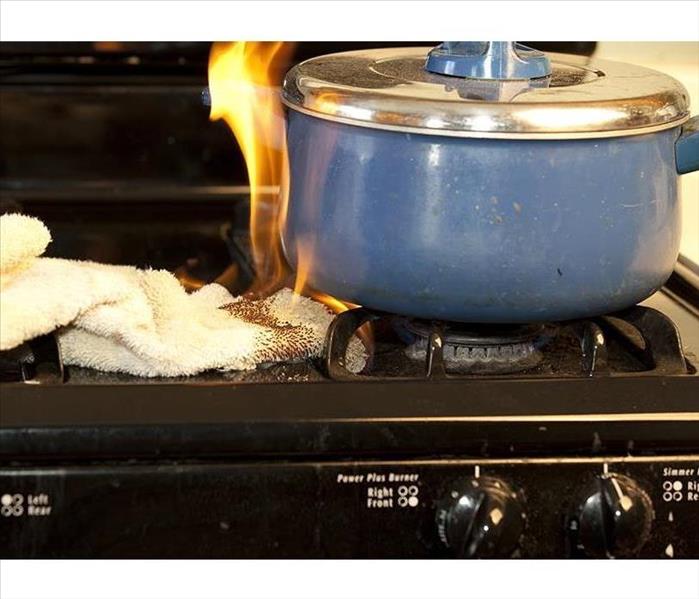 Kitchen Fire Restoration in Chesapeake
Kitchen Fire Restoration in Chesapeake
Cooking Fire Safety
Cooking is the leading cause of home fires and home fire injuries. Travelers Insurance offers these safe cooking behaviors to help keep you and your family safe.
Never leave your cooking equipment unattended while cooking, turn it off.
Don’t wear loose clothing, roll up your sleeves.
Keep your cooking area clean and remove any items that may explode or catch fire, like a paper or kitchen towel, oven mitt, non-dairy creamer, or flour.
Remove any grease buildup from your cooking area.
Keep a fire extinguisher in the cooking area. Be sure to have the correct type of extinguisher and know how to properly use it.
Don’t throw hot grease into the garbage. Let it cool and harden then dispose of it.
Don’t store food items in your oven. People forget that there is food in there and it could catch fire when preheating.
What do you do if you do have a cooking fire?
Your safety comes first. Leave the scene if you aren’t sure if the fire is safe enough to combat, call 911 for help. The fire department will control the fire.
If the fire is small and you are going to attempt to extinguish it, call 911 for help first. The fire can get out of control quickly and having help on the way is safer.
Never throw water on a grease fire, smother it. Watch how the water will turn to burning steam and the oil will splash and spread the fire. If you can, use a mitt to carefully slide a lid onto the pan and safely turn off the heat source. Don’t attempt to remove the pan until the fire is out and the pan has had time to cool.
Keep the door closed for an oven or microwave fire and turn off the heat and electrical source. Don’t open the door until the flames are gone.
If you suffer fire damage, call us for your Fire Damage Restoration in Chesapeake.
How to Avoid a Fire Disaster this Holiday Season
11/1/2018 (Permalink)
 Kitchen Fire Safety in Chesapeake
Kitchen Fire Safety in Chesapeake
SERVPRO of Chesapeake North wants to help you avoid a fire disaster this holiday season. November is a time of the year that inspires family get togethers, like Thanksgiving. As you begin the holiday season, and are busy whipping up delicious dishes, it’s also important to take time to remember safety. Thanksgiving is the peak day for home cooking fires, followed by Christmas Day and Christmas Eve.
Cooking fires are the leading cause of home fires and home-fire-related injuries in the U.S. According to the NFPA (National Fire Protection Agency), cooking equipment and heating equipment are the leading causes of home fire deaths, read more at Thanksgiving Safety and watch the Potential Danger of Turkey Fryers
If you have a cooking fire, consider just getting out and when you leave close the door behind you to help contain the fire. Then call 9-1-1 or the local emergency number after you leave. Consider for an over fire, to turn off the heat and keep the door closed and to keep a lid nearby when cooking to smother small grease fires.
SERVPRO® of Chesapeake North want you, your family, and your property to stay safe. If you do experience a fire or water damage during the holidays, or any time of the year, we can make it “Like it never even happened.”
November is Military Family Month. SERVPRO® of Chesapeake North would like to thank all service members and their families during Military Family Month and all year-round.
Best Smart Smoke/Carbon Monoxide Detector of 2018
5/31/2018 (Permalink)
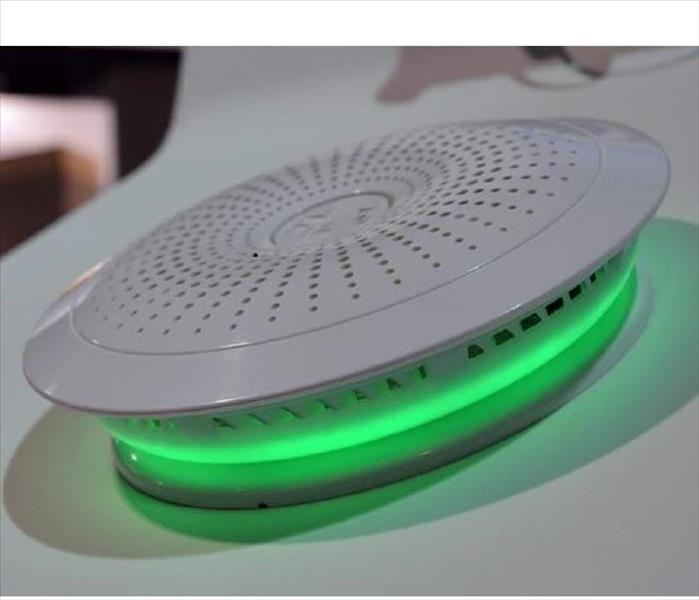 Best Smart Smoke/Carbon Monoxide Detector of 2018
Best Smart Smoke/Carbon Monoxide Detector of 2018
The best smart smoke/carbon monoxide detectors of 2018 were picked recently by Reviewed.com and shared on This Old House.
The top smoke detectors and monitors on the market were put through their paces before being selected.
Regular smoke detectors beep when they sense smoke, and if they are not connected to a fire department, are only valuable if you are home.
Smart smoke detectors will send you a push notification when the alarm goes off, and give you a heads up when the battery is low. The top pick Halo+ excelled with its speed of notifications whether connected to WiFi or not, detecting smoke or carbon monoxide. Read more about best right now.
At SERVPRO of Chesapeake North, we know about Fire Damage Cleanup and Restoration. Let us help make it like it never even happened.
A Fire Loss Estimate of Your Chesapeake Property
5/4/2018 (Permalink)
 Kitchen Fire Loss in Chesapeake Residence
Kitchen Fire Loss in Chesapeake Residence
The fire trucks are gone and now your Chesapeake home and belongings are likely suffering from not only fire and smoke damage, but also extensive water damage from the firefighting efforts. The restoration of your home and estimation of your fire loss begins when you call your local SERVPRO of Chesapeake North.
Our SERVPRO Professionals in Electronics, Structure, and Contents Restoration arrive to conduct pretests, while inspecting the property to determine the extent of fire damage and the scope of needed cleaning, restoration, and repairs. These professional experts need to identify and consider the following and are only few to mention:
- The materials, and items affected by smoke or fire and the proper method for cleaning;
- If your personal belongings need to be relocated while your house is being restored
- The areas that were not affected by soot and odor and protect those areas as soon as possible to avoid contamination
- If the smoke residues are cleanable
- Conduct a complete inventory of items that are damaged beyond repair as a complete inventory is invaluable
- The amount of time needed to perform the cleanup with the most effective cleaning methods
Once the fire damage mitigation begins, you will be kept informed and your questions will be answered throughout the process. #AlwaysHereToHelp
Need an estimate for fire damage? Call our office at (757)-465-9700
Spring Wildfire Season is Here. . . Are you Prepared Chesapeake?
4/25/2018 (Permalink)
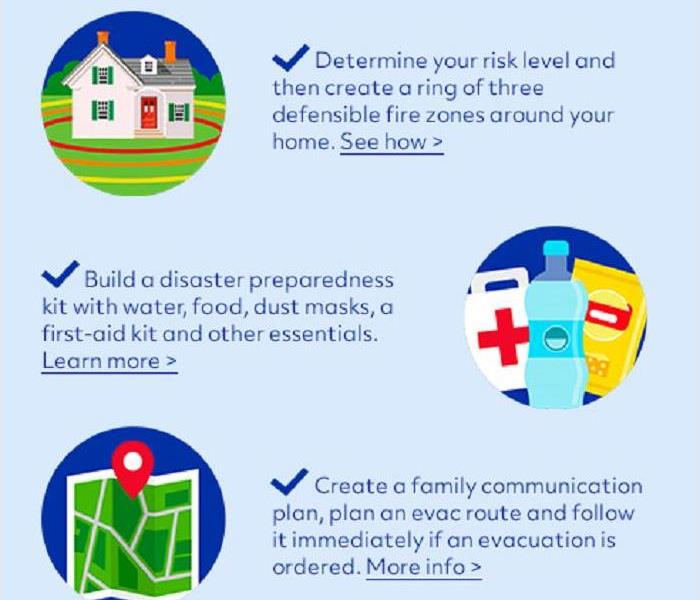 SERVPRO of Chesapeake North, 757-465-9700
SERVPRO of Chesapeake North, 757-465-9700
Spring wildfire season is here . . . are you prepared?
February 15th was the start of the spring wildfire season in the commonwealth. The Virginia Department of Forestry says that we are in good shape for the beginning of the season thanks to the rain helping to add moisture to the fire fuels, like dry grass, straw and leaves, the biggest fuels for wildfires.
The Department also reminds us that the outdoor burning law went into effect on the 15th, meaning you have to wait to burn till after 4:00 p.m. and if it’s windy, or dry outside, postpone the burning. Read more
Our friends at Allstate say that the best defense is to be prepared and offer these steps that you can take to prepare your family property and home.
- Determine your risk level and then create a ring of three defensible fire zones around your home.
- Build a disaster preparedness kit with water, food, dust masks, a first-aid kit and other essentials.
- Create a family communication plan, plan an evac route and follow it immediately if an evacuation is ordered.
Fire damage can be devastating for you and your family. SERVPRO of Chesapeake North will provide you with caring and expert guidance through the crisis. Please refer to our Fire Damage Tips-Until Help Arrives Guide and follow these tips to protect yourself and your property.
The Behavior of Smoke
12/6/2017 (Permalink)
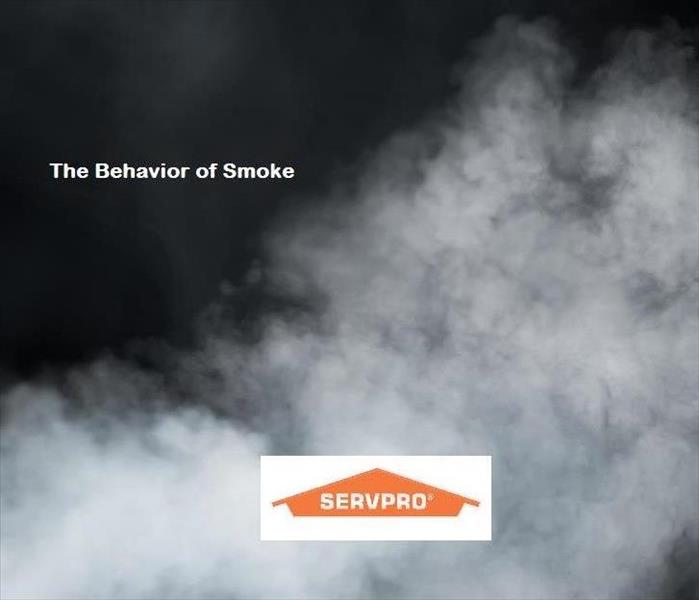 SERVPRO of Chesapeake North, 757-465-9700
SERVPRO of Chesapeake North, 757-465-9700
Following a fire, there are two different types of smoke, wet and dry. As a result there are different types of soot residue after a fire.
- Wet Smoke (Plastic and Rubber) Low heat, smoldering, pungent odor, sticky, smeary. Smoke webs are more difficult to clean.
- Dry Smoke (Paper and Wood) Fast burning, high temperatures; heat rises, therefore smoke rises.
- Protein Fire Residue (Produced by evaporation of material rather than from a fire) Virtually invisible, discolors paints and varnishes, extreme pungent odor.
- Fuel Oil Soot (Furnace Puff Backs) While "puff backs" can create havoc for homeowners, SERVPRO Franchise Professionals can, in most cases, restore the contents and structure quickly.
- Other Types (Tear gas, fingerprint powder, and fire extinguisher residue) Special loss situations require special care.
SERVPRO of Chesapeake North Franchise Professionals are thoroughly trained in fire cleanup and restoration and know the different types of smoke and their behavior patterns.
Safe Holidays are Happy Holidays
12/5/2017 (Permalink)
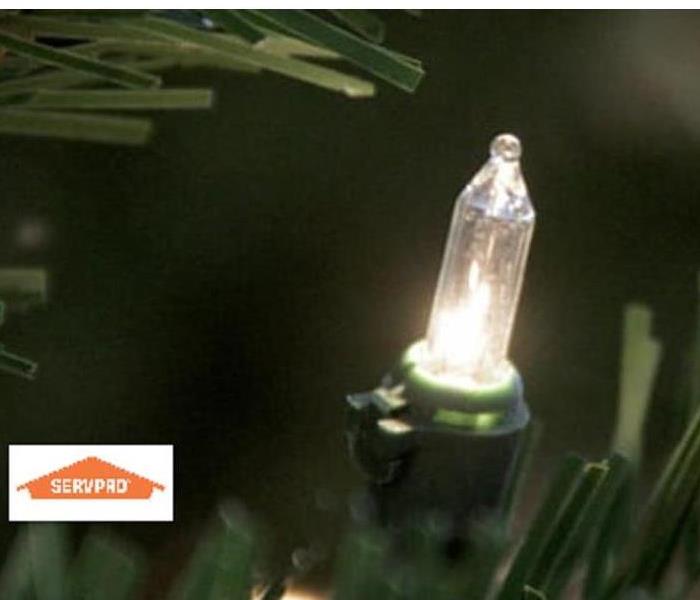 SERVPRO of Chesapeake North, 757-465-9700
SERVPRO of Chesapeake North, 757-465-9700
Safe holidays are happy holidays. As you begin to decorate your home or office remember. . .
- Inspect your lights before you hang them
- Replace old lights
- Never connect more than 3 strings of lights at a time
- be mindful of low-hanging or damaged wires to protect your pets and children
The Consumer Product Safety Commission offers up holiday decoration safety tips and general rules for Holiday Safety on products we use to decorate with like "Snow", Paper, Trimmings, Candles, Trees, and lights.
SERVPRO of Chesapeake North has been serving the community since 1967. We are dedicated to helping customers when disaster strikes and helping to make it "Like it never even happened." We are ready 24/7, 365 at 757-465-9700.
Have Questions? Call Us Today – (757) 465-9700
Thanksgiving Cooking Safety and the American Red Cross
11/15/2017 (Permalink)
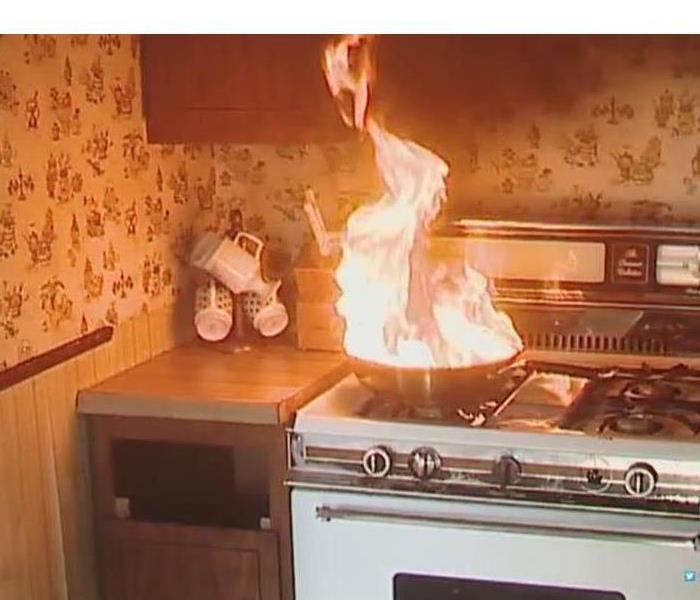 SERVPRO® of Cheapeake North, 757-465,9700
SERVPRO® of Cheapeake North, 757-465,9700
Scott Salemme, Regional CEO of the American Red Cross of the Greater Chesapeake Region said “Cooking is the number one cause of home fires, so we also have information cooks can follow to avoid a fire.”
When we come together as family and as friends to prepare the Thanksgiving meal and share in the “how to” of family recipes, it is easy to get caught up in the festive moment and to forget the potential hazards.
While cooking, remember to avoid wearing your robe, loose fitting clothing or dangling sleeves. Never leave the stove unattended, even for bathroom breaks, just turn it off. Here the American Red Cross suggests more cooking safety steps
At SERVPRO of Chesapeake North has been serving the community since 1967. We are dedicated to helping customers when disaster strikes and helping to make it “Like it never even happened.” We are ready 24/7, 365 at 757-465-9700.
Fix Up Your Firebox
10/24/2016 (Permalink)
Unsightly cracked and crumbling mortar inside a fireplace can be fixed in minutes with a few simple tools.
The mortar in most brick joints consists of sand, lime, and Portland cement. But in a fireplace, that mix just crumbles away when subjected to roaring wood fires. For this application, masons rely on a refractory mortar made of magnesium silicate, which can withstand beat up to 2,000 degrees F. Yet even refractory mortar can fail as the brickwork expands and contracts with repeated fires. Fortunately, fixing those damaged joints is a snap, thanks to high-temp fireplace mortars packaged in caulk tubes.
Tools Needed:
- Nitrile gloves
- 5-gallon bucket
- Sponge with abrasive pad
- Grout-removal tool with triangular carbide blade
- Stiff-bristle brush
- Wet/dry vac
- Nylon-bristle brush
- Refractory mortar
- Caulk gun
- Tuck-point trowel
STEPS
- Wash the brick: Put on nitrile gloves, then thoroughly scrub soot off the sides of the firebox with an abrasive pad on a wet sponge. Soot dissolves fairly easily when wet. The washing also dampens the brick and mortar, a necessary step before repointing.
- Dig out the loose mortar: Using a grout-removal tool fitted with a triangular carbide blade, scrape out cracked, loose, and crumbling mortar. Stop when the sides of the blade touch the edges of the brick. The blade’s triangular shape prevents it from going too deep (more than half the width of the joint). Clean the joints with a narrow, stiff-bristle brush and sweep up the mortar crumbs with a wet/dry vac.
- Wet the joints: Go over all the scraped joints with a nylon paintbrush, dipping repeatedly into a bucket of clean water. Refractory mortar bonds best to a damp surface, and the brush bristles ensure that all of the old brick and mortar are moistened.
- Caulk the joints: After slipping a tube of refractory mortar into a caulk gun, drag the tube’s nozzle over all the scraped mortar joints, leaving behind a fat bead of caulk. Make sure to fill any gaps between the hearth and the firebox floor.
- Pack the mortar: Use a 3/8-inch-wide tuck-pointing trowel to smooth and press the soft mortar firmly into each of the joints, then scrape off the excess with the trowel’s edge. In corners, use a gloved finger to pack and smooth.
- Wipe away the residue: Multiple swipes with a damp sponge with remove most of the mortar residue. Wipe the brick again in 24 hours, after the remaining residue dries to a haze. This mortar’s heat-resistant qualities kick in when it reaches 500 degrees. Either a heat gun or a small, brief fire will serve the purpose.
Keeping your firebox in tip-top shape is just one step in keeping your fireplace in good working order, and preventing home fires.
The Nose Knows
9/26/2016 (Permalink)
Here’s an interesting story of a contents manager who was faced with an interesting challenge!
There had been a chimney fire. The homeowner climbed up on his roof and extinguished the blaze by spraying a fire extinguisher down the chimney from above. It worked, but there was a large amount of smoke. When the homeowner opened his front door to go back in, the resulting draft sucked the smoke and soot back down the chimney and through the house.
The smoke billowed through a trophy room of mounted animal heads, coating everything in its path and saturating various items with strong smoke odors. The moose, elk, and deer trophies were fragile, so the contents manager decided not to use soot sponges as it may remove the hair from the taxidermy. Instead she used strong HEPA-filtered vacuums and a mild cleaning solution for the eyes and antlers.
In the kitchen, soot sponges were used first to determine whether there were smoke particles on the inside of the cabinets (if a sponge is passed gently over a smoke-laden cabinet or counter, it will come back with black smears or dark lines). Discovering no soot or ash on the surface of the cabinets nor on the inside, she opted not to clean out the insides of the cabinets and shelves, then went back for a final check of everything else.
What is the final check? The same one the homeowner would eventually use – the sniff test! The contents professional came within an inch of the taxidermy and sniffed along the fur- no smoke odor could be detected. The nose knows!
The manager mentioned that had there been any smoke or soot in the cupboards, she would have thrown out all the opened boxes of food and even those sealed boxes with thin cardboard containers or even thinner plastic bags where there would be too much risk of contamination. Of course nothing is discarded without talking things over with the owner and getting a “disposal authorization” form signed.
That is how we here at SERVPRO of Chesapeake perform: easy, simple, and well thought out.
Chesapeake Smoke and Soot Cleanup
7/11/2016 (Permalink)
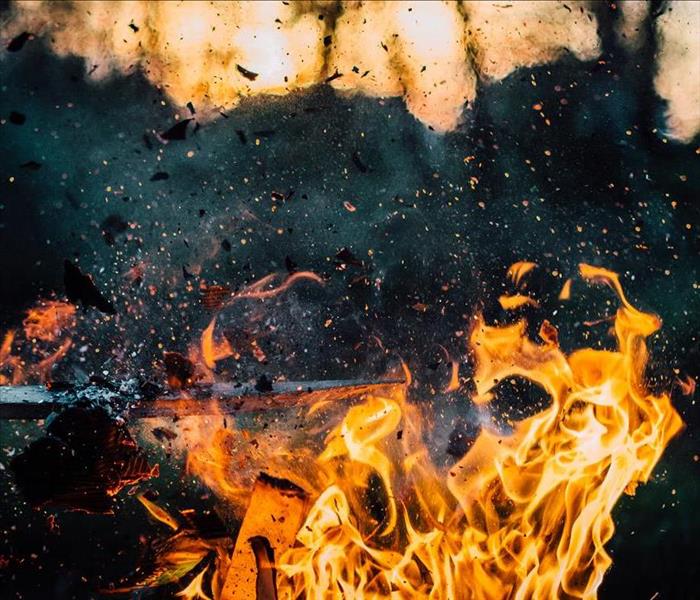 Smoke and soot damage can cause a pervasive odor in you Chesapeake home.
Smoke and soot damage can cause a pervasive odor in you Chesapeake home.
Smoke and soot is very invasive and can penetrate various cavities within your home, causing hidden damage and odor. Our smoke damage expertise and experience allows us to inspect and accurately assess the extent of the damage to develop a comprehensive plan of action.
Smoke and soot facts:
· Hot smoke migrates to cooler areas and upper levels of a structure.
· Smoke flows around plumbing systems, seeping through the holes used by pipes to go from floor to floor.
· The type of smoke may greatly affect the restoration process.
Different Types of Smoke
There are two different types of smoke–wet and dry. As a result, there are different types of soot residue after a fire. Before restoration begins, SERVPRO of Chesapeake will test the soot to determine which type of smoke damage occurred. The cleaning procedures will then be based on the information identified during pretesting. Here is some additional information:
Wet Smoke – Plastic and Rubber
· Low heat, smoldering, pungent odor, sticky, smeary. Smoke webs are more difficult to clean.
Dry Smoke – Paper and Wood
· Fast burning, high temperatures, heat rises therefore smoke rises.
Protein Fire Residue – Produced by evaporation of material rather than from a fire
· Virtually invisible, discolors paints and varnishes, extreme pungent odor.
Our Fire Damage Restoration Services
Since each smoke and fire damage situation is a little different, each one requires a unique solution tailored for the specific conditions. We have the equipment, expertise, and experience to restore your fire and smoke damage. We will also treat your family with empathy and respect and your property with care.
Have Questions about Fire, Smoke, or Soot Damage?
Call Us Today – (757)465-9700.
Grill Fire Safety in Chesapeake
6/27/2016 (Permalink)
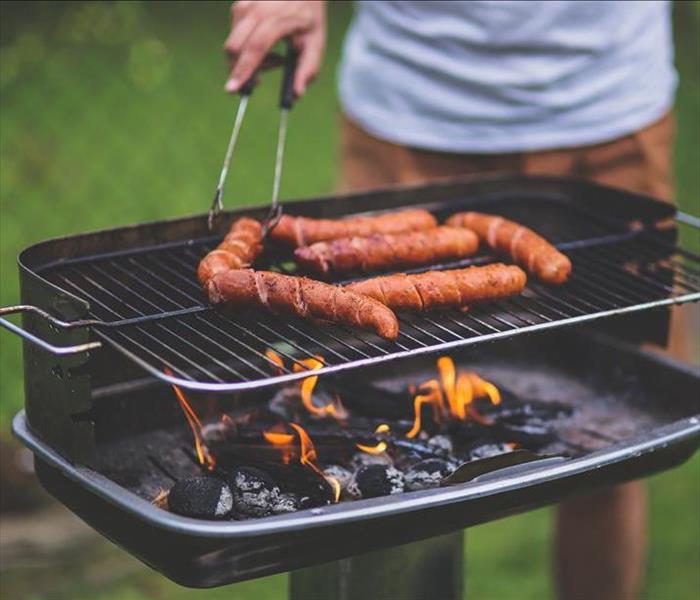 Keep your home safe this summer by following these grilling tips.
Keep your home safe this summer by following these grilling tips.
Warmer weather brings hot grills and tasty meals. However, a fun backyard cook-out can quickly turn into a dangerous fire situation. It is important to practice safe grilling habits to keep your outdoor fun going all summer long.
Statistics
Each year an average of 8,900 home fires are caused by grilling, and close to half of all injuries involving grills are due to thermal burns. While nearly half of the people who grill do it year-round, July is the peak month for grill fires followed by May, June and August. A failure to clean the grill was the leading factor contributing to the fire in one –fifth of all grill structure fires (19%). In 17%, something that could catch fire was too close to the grill. Leaks or breaks were the factor in 11% of grill structure fires and 23% of outside and unclassified grill fires. Gas grills contribute to a higher number of home fires overall than their charcoal counterparts.
Do:
1. Keep your grill at least 10 feet away from your house. Farther is even better. This includes portions attached to your house like carports, garages and porches. Grills should not be used underneath wooden overhangs either, as the fire could flare up into the structure above. This applies to both charcoal and gas grills.
2. Clean your grill regularly. If you allow grease and fat to build up on your grill, they provide more fuel for a fire. Grease is a major source of flare ups.
3. Check for gas leaks. You can make sure no gas is leaking from your gas grill by making a solution of half liquid dish soap and half water and rubbing it on the hoses and connections. Then, turn the gas on (with the grill lid open.) If the soap forms large bubbles, that's a sign that the hoses have tiny holes or that the connections are not tight enough.
4. Keep decorations away from your grill. Decorations like hanging baskets, pillows and umbrellas look pretty AND provide fuel for a fire. To make matters worse, today's decor is mostly made of artificial fibers that burn fast and hot, making this tip even more important.
5. Keep a spray bottle of water handy. That way, if you have a minor flare-up you can spray it with the water to instantly calm it. The bonus of this tip is that water won't harm your food, so dinner won't be ruined!
6. Keep a fire extinguisher within a couple steps of your grill. And KNOW HOW TO USE IT. If you are unsure how to use the extinguisher, don't waste time fiddling with it before calling 911. Firefighters say many fire deaths occur when people try to fight a fire themselves instead of calling for expert help and letting the fire department do its job.
Don't:
7. Turn on the gas while your grill lid is closed. NEVER do this. It causes gas to build up inside your grill, and when you do light it and open it, a fireball can explode in your face.
8. Leave a grill unattended. Fires double in size every minute. Plan ahead so that all of your other food prep chores are done and you can focus on grilling.
9. Overload your grill with food. This applies especially to fatty meats. The basic reason for this tip is that if too much fat drips on the flames at once, it can cause a large flare-up that could light nearby things on fire.
10. Use a grill indoors. People often think it will be safe to use a grill, especially a small one, indoors. NOT TRUE. In addition to the fire hazard, grills release carbon monoxide, the deadly colorless, odorless gas. That gas needs to vent in fresh air.
If a fire does occur this summer, call SERVPRO® of Chesapeake at (757)465-9700. Our trained team will work to make it “Like it never even happened.”
Preventing Home Fires- Fireplaces and Woodstoves
3/23/2016 (Permalink)
Safety Tips:
- Inspect and clean woodstove pipes and chimneys annaully. Check monthly for damage or obstructions.
- Never brun trash, paper, or green wood.
- Use a fireplace screen heavy enough to stop rolling logs and big enough to cover the entire opening of the fireplace to catch flying sparks.
- Make sure the fire is completely out before leaving the house or going to bed.
- Store cooled ashes in a tightly sealed metal container outside the home.
For Emergency Restoration Services, Call Us! 757-465-9700
Are Your Smoke Alarms Up-to-Date?
3/14/2016 (Permalink)
Smoke alarms are important to have in our homes and in proper working condition. When installed and properly maintained, smoke alarms can reduce the risk of injuries caused by fires in half.
The National Fire Protection Association recommends that smoke alarms are to be installed in every bedroom, outside all sleeping areas, and on every level of the house. Business owners should consult the local Fire Marshall to ensure specific building fire codes and smoke detectors requirements are met.
Review the following tips regarding smoke detector installation and maintenance:
-Install smoke alarms on every level of the home. Think about how you are placing an alarm. Make sure it is in a location that, if there were a fire, it would quickly detect the smoke. Do not install the smoke alarm where it could be blocked.
- Smoke alarms should be installed away from the kitchen and shower to prevent false alarms. Generally, they should be at least 10 feet from a cooking appliance.
-Test smoke alarms at least once a month using a test button. Set the date on your calendar. This is also a good time to review and practice your emergency escape plan.
-Replace batteries in all smoke alarms at least once a year, though twice would be optimal. Daylight savings time can be good dates to set for this. Again, try to schedule this on your calendar. If an alarm "chirps" the battery is low and should be replaced right away.
-Replace all smoke alarms when they are 10 years old. If you do not know how old your smoke alarm is, go ahead and replace it. Newer alarms on the market also offer carbon monoxide detection as well as voice alarms, which have shown to be more effective in waking children up.
Here at SERVPRO Chesapeake, we believe in PREVENTION first.






 24/7 Emergency Service
24/7 Emergency Service
